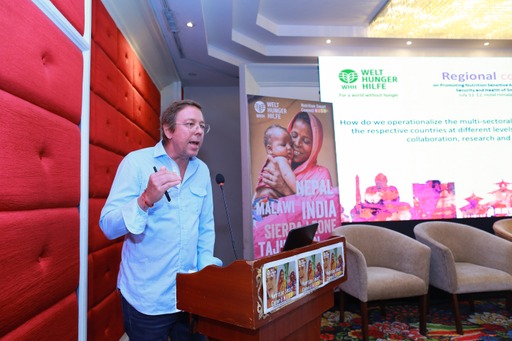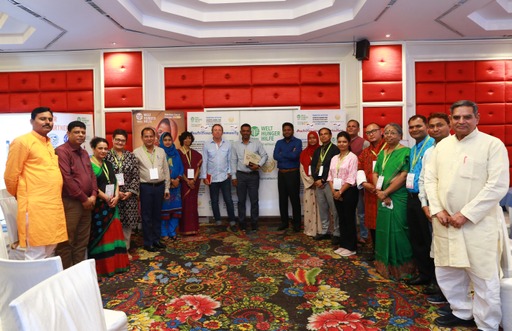Experts highlight urgent need for nutrition-sensitive agriculture solutions to address the problem
KATHMANDU, July 13: South Asia that covers only 3% of the world's landmass accommodates approximately 24% of the global population; the region faces the highest population density worldwide. Around 67% of the population resides in rural areas and relies on agriculture, fisheries, and forest products for their livelihoods. Yet, undernutrition remains a significant challenge, impacting an estimated 267 million individuals.
South Asian Association for Regional Cooperation (SAARC) and Welthungerhilfe (WHH) hosted a Regional Consultation Meeting on July 11-12 focused on addressing the issues of nutrition and health in South Asia. The consultation meeting titled "Promoting Nutrition Sensitive Agriculture for Improving Nutrition Security and Health of Smallholders in South Asia," brought together key stakeholders to collectively tackle the challenges faced by smallholder farmers in the region.

The workshop hosted about 30-35 participants, including high-profile dignitaries, representatives from SAARC member countries, government officials from Bangladesh, India, and Nepal, and personnel from Welthungerhilfe (WHH) and its collaborative partners. During the workshop, the seven SAARC countries presented their country situations, focusing on specific thematic areas and sharing lessons and experiences from the WHH Nutrition Smart Communities in Bangladesh, India, and Nepal. Informative keynote presentations covered the transformation of food systems and nutrition, as well as provided an overview of the status of child nutrition in South Asia during the ongoing global crisis.
According to the Global Hunger Index, South Asia has the highest hunger level globally, with the highest child stunting rate and child wasting rate among all world regions. Recognizing the urgency to achieve the Sustainable Development Goals (SDGs), particularly SDG II, which aims to end hunger, the SAARC Agriculture Vision 2020 highlighted the need for food and nutrition security in the region. In response, the regional consultation meeting adopted a targeted approach to establish a connection between agriculture, nutrition, and health. Stakeholders aimed to improve the nutrition and health outcomes of smallholder farmers and consumers by promoting nutrition-sensitive agriculture.
Regional Consultation Meeting on “Promoting Nutrition Sensitive...


The event's chief guest was Dr Bedu Ram Bhusal, the Minister of Agriculture and Livestock Development from Nepal. During the event, representatives from SAARC countries presented papers about their respective countries. A snapshot of the agri-food system in South Asia revealed that around 50% (850 out of 1980 million) of people in SA are experiencing moderate to severe food insecurity. This region currently has the highest number of poor and malnourished people globally. The food system is at a significant risk due to its heavy reliance on a limited number of food sources. To address this issue, an alternative approach was proposed, which involves shifting from the mainstream practices of monoculture, mechanization, and technology-led approaches to diversified, localized, and farmer-led strategies. In August 2022, the National Food and Nutrition Security Policy (NFNSP) was established, aiming to ensure the availability of safe and nutritious food, strengthen coordination, and provide access to affordable, healthy food.
Dr Mohahmad Razu Ahmed, Deputy Secretary and Component Director of the Smallholder Agricultural Competitiveness Project (SACP), discussed the nutrition situation in Bangladesh. He highlighted that 50.9% of children under 5 years old experience mild to moderate Vitamin A deficiency, while 21.9% suffer from Vitamin D deficiency. Dr. Ahmed identified several challenges, including poor coordination among stakeholders, limited food variety, and incorrect cooking methods.
Ratu Kinley from the Research and Development Centre Samtenling, Ministry of Agriculture and Livestock (MoAL) in Bhutan shared some important insights. Agriculture and livestock accounted for 15.82% of Bhutan's GDP in 2019. However, there is a concerning lack of food diversity, as rice consumption per person in Bhutan was 150 kg per year, much higher than the global average of 78.43 kg per year. This imbalance suggests a limited variety of food choices in Bhutan. Another issue highlighted by Ratu Kinley is the prevalence of micronutrient deficiencies in the population. In terms of health challenges, non-communicable diseases (NCDs) pose the biggest threat in Bhutan. NCDs accounted for 71% of all deaths in the country in 2019, affecting people of all age groups.
Dr Ashis Kumar Samanta, Professor and Head of the Animal Nutrition Division at the ICAR-National Dairy Research Institute in India, stated that India, with a population of 1.42 billion people, which accounts for 17.7% of the global population, has successfully reduced extreme poverty by half. However, the country still faces significant challenges such as child mortality, underweight children, and stunting.
Sujan Dhungel, a Senior Monitoring and Evaluation Officer at the Ministry of Agriculture and Livestock Development in Nepal, presented important information regarding agriculture and the economy. He highlighted that out of the total cultivable land in Nepal, 28%, only 21% is currently being cultivated. This indicates that there is potential for further agricultural development.
According to the Ministry of Finance (MoF) in 2023, the economy of Nepal heavily relies on agriculture, accounting for 24.12% of the GDP and employing a significant portion of the labor market. This emphasizes the crucial role of agriculture in the country's overall economic stability and employment opportunities.
The findings from the Nepal Living Standard Survey (NLSS) III revealed that relying solely on food consumption as an indicator of nutritional improvement is not sufficient. Therefore, it is important to consider additional factors when assessing the nutritional status of the population.
Recognizing the need for improvement, the Nepali government has made a commitment to achieving globally agreed-upon World Health Assembly global nutrition targets by 2025 and is also working towards achieving goal 2 of the Sustainable Development Goals, which aims to eliminate hunger worldwide by 2030. These initiatives reflect the government's dedication to ensuring food security and nutrition for its citizens.
Shareefa Ali, an Agriculture Officer from Maldives, expressed concern about the critical state of agriculture in her country. Maldives currently has a meager total of six agriculture officers, including Shareefa herself. She highlighted that farmers in Maldives are primarily focused on maximizing profits, leading them to cultivate only the most financially rewarding crops. However, there is a potential opportunity in the realm of aquatic food production if appropriate policies and approaches are implemented.
The workshop included technical sessions focused on Nutrition Smart communities. These sessions aimed to learn from community-based interventions and featured a panel discussion led by Pankaj Kumar, Country Director of Welthungerhilfe Bangladesh. The panel discussed policies to strengthen nutrition-sensitive agriculture, which can help improve the nutritional security and health of smallholders in the region.
The initiative employed a comprehensive approach involving multiple sectors and stakeholders. It encompassed integrated farming systems that connect agriculture and natural resource management to ensure nutrition security. Additionally, the project emphasized institution building, nutrition education, nutrition-sensitive village micro-planning, and access to government food and nutrition programs. Implemented across approximately 260 vulnerable villages in Bangladesh, India, and Nepal, the Nutrition Smart Community project operates under the larger initiative called the "Regional Program for Promoting a Multisectoral Approach for Nutrition Smart Villages in Bangladesh, Nepal, and India."

The Regional Consultation Meeting yielded several outcomes, including a country-level analysis of nutritional status, identification of key measures relevant to nutrition-sensitive agriculture, exploration of opportunities for promoting and expanding nutrition-sensitive agriculture in the region, and the publication of a comprehensive book capturing the findings and recommendations.


































